Chapter: 10th Social Science : History : Chapter 3 : World War II
Causes, Course and Effects of World War II
Causes, Course and Effects of World War II
(a) Causes
The devastation caused by World War I was of such magnitude that it was referred to as The Great War, or The War to End All Wars. The belligerent nations, especially the Allies, had no desire for a second prolonged conflict, and this was the main driving force behind their actions after the end of World War I. The immediate and primary cause of World War II was the aggressive military offensive undertaken by a resurgent Germany and a fast developing Japan.
Germany and Treaty of Versailles, 1919
The Treaty of Versailles ending World War I was signed in June 1919. Among the many clauses of the Treaty, three in particular caused great resentment among the Germans. (i) Germany was forced to give up territories to the west, north and east of the German border; (ii) Germany had to disarm and was allowed to retain only a very restricted armed force; (iii) as reparations for the War, Germany was expected to pay for the military and civilian cost of the War to the Allied nations.
Failure of League of Nations
The Treaty also set up the League of Nations, on the initiative of President Woodrow Wilson of the United States. The League was expected to mediate between countries and take action against countries which indulged in military aggression. The popular mood favoured the traditional isolationist approach, and therefore the United States did not become a member of the League. The other Allied nations were also determined to maintain a non-interventionist attitude and, in consequence, the League remained an ineffectual international body.
Post-War Crisis and Germany
As mentioned above the three main clauses of the Treaty of Versailles, especially the imposition of penal reparations caused great discontent in Germany. The problems which many countries faced in the post-World War I decades led to the rise of extreme right wing dictatorships in Italy (Mussolini), Germany (Hitler) and Spain (Franco).
Germany experienced both high unemployment and severe inflation after the War, and its currency became practically worthless. There are several pictures of the 1920s when ordinary people had to carry money in wheelbarrows to buy bread. This was blamed on the war reparations which Germany was forced to pay, though in the final analysis, the demands for war reparations were moderated over several rounds of negotiations.
The Rise of Adolf Hitler
Adolf Hitler was able to exploit the general discontent among the Germans. Gifted with great oratorical skills, he was able to sway the people by his impassioned speeches, promising a return to the glorious military past of Germany. He founded the National Socialist party, generally known as “the Nazis”. The fundamental platform on which Hitler built his support was the notion of the racial superiority of the Germans as a pure, ‘Aryan’ race and a deep-seated hatred of the Jews. Hitler came to power in 1933 and ruled Germany till 1945.
In direct contravention of the clauses of the Treaty of Versailles, Hitler began to re-arm Germany. The recruitment for the armed forces and the manufacture of armaments and machinery for the army, navy and air force with large amounts of government spending resulted in an economic revival and solved the problem of unemployment in Germany.
Italy’s break with Britain and France in the wake of Mussolini’s invasion of Ethiopia resulted in better relationship between Italy and Germany. In 1936, before Germany invaded the Rhineland, which was supposed to be a demilitarised zone, Rome - Berlin Axis had come into being. Later, with Japan joining this alliance, it became Rome-Berlin-Tokyo Axis. In 1938, Hitler invaded Austria and Czechoslovakia. Sudetenland in Czechoslovakia was German speaking, and Hitler’s claim was that the German speaking people should be united in to one nation.
Allies and Non-Intervention
There were also acts of aggression by Italy and Japan. Italy invaded Ethiopia in 1935 and Albania in 1939. Emperor Haile Selassie of Ethiopia appealed to the League of Nations, but got no help. In the East, Japan was pursuing its policy of military expansion. In 1931, Japan invaded Manchuria, and in 1937 it invaded China and seized Beijing. All these were ignored by the Allies and the League of Nations was unable to take any action.
In spite of all these manifestations of military activity by Germany, Italy and Japan, Britain and France continued to be non-interventionist. The mood in Britain was not in favour of starting another war. Prime Ministers Baldwin and Chamberlain did not feel justified in intervening in a region which was not officially in their sphere of interest. The United States was totally indifferent to the outside world, and was concerned with the revival of the economy after the Great Depression.
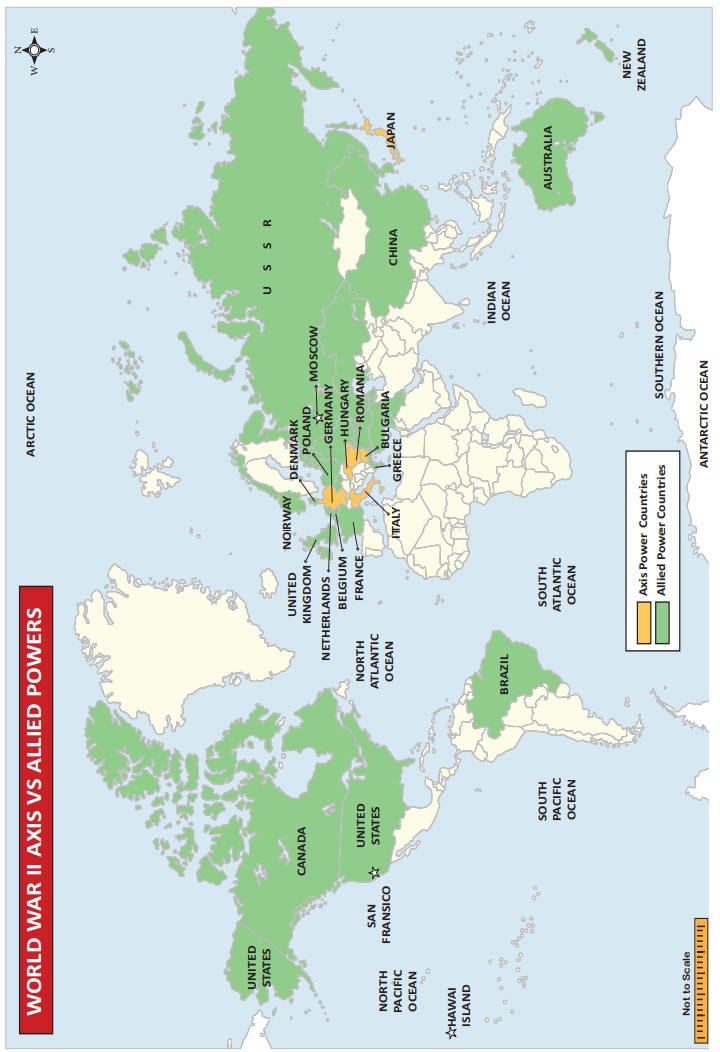
Munich Pact
A further factor was that the western powers and the Soviet Union distrusted each other. In 1938, Prime Minister Chamberlain concluded the Munich Pact with Germany, which was a shameful acceptance of Germany’s invasion of Czechoslovakia to annex German-speaking Sudetenland. In 1939 the Soviet Union independently concluded a non -aggression pact with Germany. The continued passivity of the Allies and the reluctance to start building up their armies were also contributory causes of the extended scale of World War II.
Though Hitler gave an assurance in the Munich Pact that Germany would not attack any other country, this was broken immediately. In 1939 he invaded Czechoslovakia. Poland was attacked next, and this was the final act which resulted in the declaration of war by Britain and France against Germany. In Britain, Prime Minister Chamberlain resigned in 1940 and Winston Churchill, who had always warned about Hitler and his military ambitions, became Prime Minister.
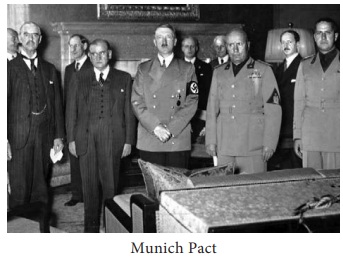
(b) Course of World War II
Nature of the War
World War II was fought on two distinct fronts - Europe and the Asia Pacific. In Europe, the war was fought by the Allies against Germany and Italy. In the Asia Pacific, the Allies fought Japan.
World War II was a modern war fought with heavy military equipment such as tanks, submarines, battleships, aircraft carriers, fighter planes and bomber planes. This involved a very large resource base, since all this equipment needed to be manufactured. There had to be raw materials, manufacturing capacity and technical inputs to improve the military hardware. This was an expensive and prolonged war of attrition.
Outbreak of War
Britain and France declared war on Germany in September 1939. In June 1940, Italy joined Germany, and in September 1940, Japan also joined the Axis powers.
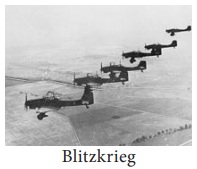
There was little action immediately after the declaration of war. Britain had already begun to build up its military capabilities, and all young men were conscripted for military duty. The first years of the War were a time of spectacular successes of the Germany army which occupied Denmark and Norway and later France. By 1941, all of mainland Europe till the Russian frontier was under the Axis powers. The German army followed a tactic of ‘lightning strike’ (Blitzkrieg) to storm into various countries and overrun them.
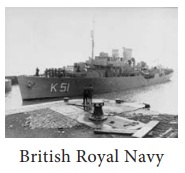
The British Royal Navy continued to be the most powerful among the European naval forces and ensured that a sea-borne invasion of Britain was not possible.
However, Britain depended on large scale imports of food, raw materials and industrial goods by sea from its Empire and the US. To attack this, Germany developed a fleet of submarines which caused havoc, especially in the Atlantic Ocean area, by sinking a large number of civilian ships carrying supplies to Britain.
Important Events
Dunkirk – In May 1940 more than 300,000 British and French soldiers were forced back to the beaches in Dunkirk. Britain would have found it difficult to regroup if so many of her soldiers had been lost at Dunkirk.
Battle of Britain– By July 1940, it was feared that the Germans were planning to invade Britain. Hitler wanted to force Britain to accept his proposals for peace by a prolonged air-borne bombing campaign. The German air force began to attack specific targets, especially the ports, airfields and industrial installations. In September 1940, London was bombed mercilessly, an action known as The Blitz. By October 1940, night bombing raids on London and other industrial cities began.
This campaign failed because with the aid of a newly developed and top secret device ‘radar’ for detecting aircraft while still at a distance, the fighter planes of the Royal Air Force (Spitfires and Hurricanes) were able to inflict severe losses on the German bombers. The raids stopped after October 1940. The Germans dropped their plans to invade Britain because of the failure of the air battle.

Lend Lease 1941–1945
President Roosevelt realized that the United States had to change its policy of isolation, but could not intervene directly in the War in Europe, because it was not politically feasible. So he started a programme of “Lend Lease” in March 1941. Arms, food, military equipment and other supplies were sent to Britain, disguised as a “loan”, which would be returned after use. This augmented the resources of Britain to a great extent. Between 1941 and 1945, the total aid under Lend Lease amounted to $46.5 billion.
Invasion of Russia 1941-1942
In June 1941 the German army invaded Russia. The long-term objectives of this move were to seize prime land for settling Germans, to destroy the communist regime, and also exploit Russia’s natural resources, especially oil. The German strategy of lightning strikes was initially successful and the army penetrated 1000 miles into Russian territory very soon. The German army then marched on Moscow. But ultimately, the resistance by the Soviet army, and the fierce Russian winter defeated the German army.
Battle of Stalingrad (17 July 1942 to 2 February 1943)
In August 1942, the Germans attacked Stalingrad.Stretching about 30 miles (50 km) along the banks of the Volga River, Stalingrad was a large industrial city producing armaments and tractors. Capturing the city would cut Soviet transport links with southern Russia, and Stalingrad would then enable the invading Germans to have access to the oil fields of the Caucasus. In addition, seizing the city that bore the name of Soviet leader Stalin would serve as a great personal and propaganda victory for Hitler. German war planners hoped to achieve that end with Fall Blau (“Operation Blue”). On June 28, 1942, operations began with significant German victories.
Russian people suffered not only from bad working and living conditions, but also from ill-treatment at German hands in the occupied areas. There were about 15 million civilian deaths during the war, and about 10 million members of the armed forces were killed. All together over one-tenth of Russia’s population died. Yet the people remained loyal to the government, despite Hitler’s hopes of an anti-Stalin revolution. They successfully defended the city of Stalingrad.
Battle of El Alamein 1942
In the early years of the War, German forces under General Rommel were remarkably successful in occupying North Africa rapidly, leaving the British with only Egypt. The Allied forces under General Montgomery counter-attacked and defeated the German and Italian forces at El Alamein in North Africa. The German army was chased across the desert, out of North Africa. This provided the base for the Allied forces to invade Italy.
Surrender of Italy 1943
Mussolini had been thrown out and the new government of Italy surrendered to the Allies in 1943. However, the Germans set Mussolini up in a puppet regime in the north. Mussolini was killed in April 1945, by Italian partisans.
End of Hitler
The Allied forces under the command of General Eisenhower invaded Normandy in France. Slowly, the German army was forced back. But the Germans fought back and the War continued for nearly another year, and finally ended in May 1945. Hitler committed suicide in April 1945.
From 1944, the Russian army began to attack Germany from the East and captured much of Eastern Europe and Poland. In 1945, they occupied parts of Berlin, so that Germany was divided into two sections after the War.
War in the Asia-Pacific Region
Japan had entertained visions of a glorious empire, very much on the same lines as Hitler. The Japanese army invaded Manchuria in 1931.Though China appealed to the League of Nations, this act of aggression did not attract the attention of the United States or Britain. In 1937, Japan invaded China, and seized Beijing (Peking, as it was then known) which had traditionally been the capital of China. The region around Shanghai was also captured, and Nanjing (Nanking), the capital was captured at the end of the year. The Japanese army indulged in the biggest slaughter ever known in history in Nanjing. Civilians were killed en masse for sport, and all females – from children to old women – were tortured and killed. Guangzhou (Canton) and many other parts of China were overrun. The Chinese army, under Chiang Kai-shek retreated to the west to the hilly country from where they continued to fight the Japanese.
Pearl Harbour 1941
On December 1941, Japan attacked American naval installations in Pearl Harbour, Hawaii, without warning. The idea was to cripple America’s Pacific fleet so that Japan would not face any opposition in its offensive against South-east Asian countries. Many battleships and numerous fighter planes were destroyed. The United States declared war on Japan, with Britain and China also joining in. This brought together both the Asia Pacific and the European war into one common cause. Most importantly, it brought the United States with its enormous resources into the war as a part of the Allies.
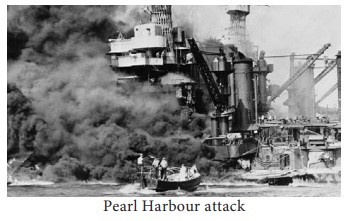
Japanese Aggression in South-east Asia
The Japanese had spectacular success in their plan to extend their empire throughout South-east Asia. Guam, the Philippines, Hong Kong, Singapore, Malaya, the Dutch East Indies (Indonesia) and Burma, all fell to the Japanese.
Battle of Midway and Battle of Guadalcanal 1942

The US navy defeated the Japanese navy in the Battle of Midway, which turned the tide in favour of the Allies. The Battle of Guadalcanal in the Solomon Islands was a combined offensive involving the army and the navy, and lasted for several months. Both were crushing defeats for the Japanese.
After this, the American forces were able to re-take the Philippines. Gradually the Japanese were thrown out of most of their conquered territories. In 1944, the combined British and Indian armies were able to push back the Japanese who attempted to invade the north-east of India. Then, along with the Chinese, they pushed the Japanese out of Burma, and liberated Malaya and Singapore.
Hiroshima and Nagasaki, August 1945
As a top secret project, using the latest scientific advances, the US developed an atomic bomb immensely more powerful than conventional explosives. The Japanese generals refused to surrender and finally the US dropped an atomic bomb on Hiroshima. As the Japanese still refused to surrender, another atom bomb was dropped on Nagasaki. Japan ultimately announced surrender on 15 August 1945 and formally signed 2 September 1945 bringing an end to World War II.
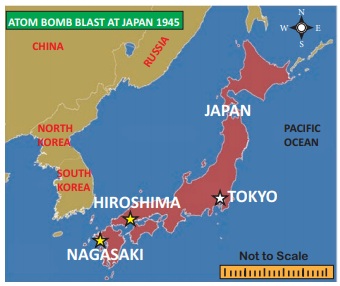
(c) Effects of the War
New geo-political power alignment: World War II changed the world in fundamental ways.
The world was polarized into two main blocs led by superpowers, one led by the United States with a pronounced anti-Communist ideology, and the other by Soviet Russia. Europe was divided into two: Communist and non-Communist.
Nuclear proliferation: The United States and the Soviet Union entered into a race to have more nuclear powered weapons. They built a large stockpile of such weapons. Defence spending sky-rocketed in many countries.
International agencies: Many international agencies, in particular the United Nations, the World Bank and the International Monetary Fund came into existence providing a forum for countries large and small.
Colonial powers were forced to give independence to former colonies in a process of decolonization. India was the first to achieve independence.
Related Topics